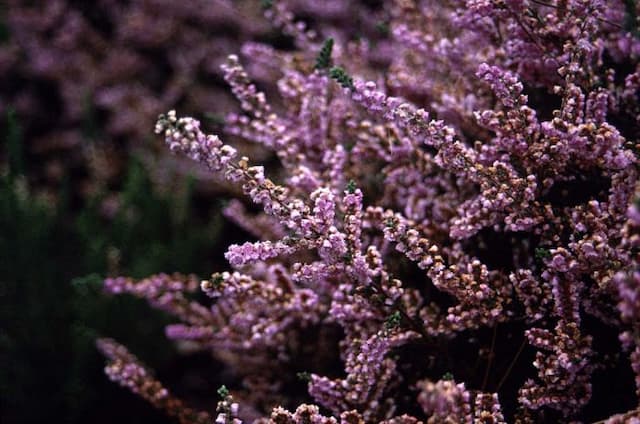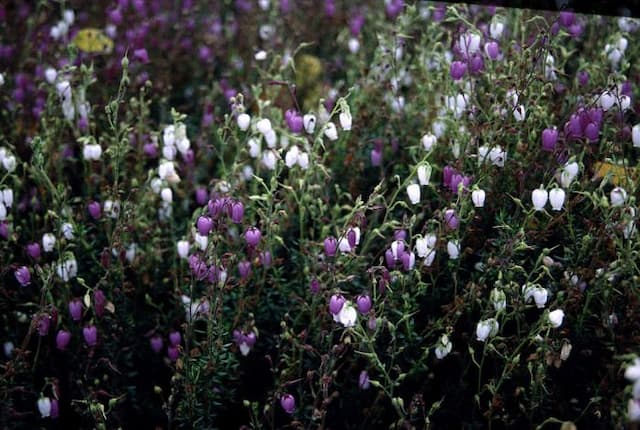Heather Garden Girls Series Calluna vulgaris Garden Girls Series

ABOUT
Garden Girls Series is a collection of compact, 'bud-blooming' heathers with dark green foliage and flower buds in a wide range of shades of red, pink and white; the flower buds do not fully open and so provide a long-lasting display of colour from summer into autumn.
About this plant
 Names
NamesFamily
Ericaceae
Synonyms
Scots Heather, Scotch Heather, Ling Heather, Heather
Common names
Calluna vulgaris.
 Characteristics
CharacteristicsLife cycle
Perennials
Foliage type
Evergreen
Color of leaves
Green
Flower color
Varies
Height
1-2 feet (30-60 cm)
Spread
1-2 feet (30-60 cm)
Plant type
Shrub
Hardiness zones
4-8
Native area
Europe
Benefits
 General Benefits
General Benefits- Low Maintenance: The plant is relatively easy to care for, requiring minimal attention once established.
- Drought Tolerant: It is resistant to periods of low water supply, making it ideal for climates with irregular rainfall.
- Attracts Wildlife: It provides food and habitat for bees, butterflies, and birds, enhancing biodiversity.
- Long Blooming Period: It offers a long flowering season from late summer to fall, adding color to gardens for an extended time.
- Winter Hardiness: The plant can survive in cold temperatures, making it suitable for a variety of climates.
- Soil Adaptability: It can thrive in a range of soil types, including poor soils, as long as they are well-drained.
- Evergreen Foliage: The plant offers year-round visual interest with its evergreen leaves, even when not in bloom.
- Landscape Versatility: It’s suitable for a variety of landscaping uses, including groundcover, borders, and rock gardens.
- Erosion Control: The plant's dense growth can help stabilize soil and prevent erosion on slopes.
- Color Variety: The Garden Girls series offers a range of colors, providing many options for garden design preferences.
 Medical Properties
Medical PropertiesThis plant is not used for medical purposes.
 Air-purifying Qualities
Air-purifying QualitiesThis plant is not specifically known for air purifying qualities.
 Other Uses
Other Uses- Erosion Control: Heather can be used on slopes and banks to help stabilize the soil and prevent erosion due to its dense root structure and low-growing habit.
- Wildlife Shelter: Providing shelter for small wildlife, heather offers a safe haven for insects, birds, and small mammals, contributing to local biodiversity.
- Livestock Forage: In some regions, heather is used as forage for grazing animals such as sheep and goats, especially in poor soil conditions.
- Thatching Material: Historically, heather has been used for thatching roofs, thanks to its durability and waterproof qualities.
- Crafts and Jewelry: Dried heather flowers can be incorporated into crafts, such as making jewelry, decorative wreaths, or potpourri.
- Fuel: Heather has been used as a source of fuel, particularly in rural areas, where its dried woody stems burn well.
- Game Cover: Heather is often planted to provide cover for game birds, such as grouse, facilitating hunting and game management.
- Beekeeping: Heather is a valuable plant for beekeepers since it produces ample nectar, which bees convert into a distinctive, jelly-like honey known as "heather honey".
- Fragrance: The flowers of heather can be used to produce a natural fragrance for perfumes or scented sachets.
- Fish Tank Decoration: Dried heather can also be used as a natural decoration in fish tanks, offering aesthetic value and shelter for fish.
Interesting Facts
 Feng Shui
Feng ShuiHeather is not used in Feng Shui practice.
 Zodiac Sign Compitability
Zodiac Sign CompitabilityHeather is not used in astrology practice.
 Plant Symbolism
Plant Symbolism- Protection - Calluna vulgaris, commonly known as Heather, has been associated with protection in various cultures. It was traditionally used to thatch roofs, providing literal protection from the elements.
- Good luck - Heather is often considered a lucky charm. In some regions, carrying a sprig of Heather is thought to bring good fortune.
- Admiration - The plant's resilient and hardy nature has made it a symbol of admiration, as it thrives on barren landscapes where other plants cannot survive.
- Solitude - Because Heather can dominate the landscape in which it grows, creating vast, single-species areas, it has come to symbolize solitude and the ability to stand strong alone.
- Beauty - The Garden Girls Series of Heather, with its vibrant and colorful blooms, often stands for beauty and admiration for the natural world's splendors.
- New beginnings - Heather blooms in late summer, a time of transition from the vibrant growing season to the dormancy of winter, making it symbolic of new starts and the cycle of life.
 Water
WaterHeather, commonly known as the Calluna vulgaris 'Garden Girls' series, requires consistent moisture but does not do well in waterlogged soil. It's best to water these plants when the top inch of soil feels dry to the touch. Generally, provide about 1 gallon of water per plant every week during the growing season, adjusting for rainfall and temperature, as they will need more water in hotter, drier weather and less during cool, wet periods. Overhead watering should be avoided to prevent fungal diseases; instead water at the base of the plant. During the winter months, reduce watering as the plant's growth slows down.
 Light
LightHeather thrives in an area where it can receive full sun to partial shade. The ideal spot for Calluna vulgaris 'Garden Girls' is one where it gets at least six hours of sunlight each day. Avoid deep shade as this will result in fewer flowers and a leggier growth habit. Morning sunlight with afternoon shade is beneficial in warmer climates to protect the foliage from intense heat.
 Temperature
TemperatureCalluna vulgaris 'Garden Girls' heathers are quite cold-hardy and can survive temperatures as low as -20 to -30 degrees Fahrenheit. They perform best in cooler climates and the ideal temperature range for growing heather is between 60 to 70 degrees Fahrenheit during the day. They can tolerate a maximum temperature of about 80 degrees Fahrenheit, but prolonged heat can stress the plants, especially if nighttime temperatures do not drop significantly.
 Pruning
PruningPrune heather or Calluna vulgaris 'Garden Girls' after flowering to prevent the bushes from becoming woody and to encourage new growth for the next season. Trimming should be done annually, ideally in the spring, removing only the top one-third of the plant's growth. Deadheading the spent flowers can also be beneficial. Pruning keeps the plants compact and promotes more abundant blooms the following year.
 Cleaning
CleaningAs needed
 Soil
SoilHeather (Calluna vulgaris Garden Girls Series) prefers well-draining, acidic soil with a pH of 4.5 to 6.0. A mix of peat moss, sand, and pine bark works well for heather, ensuring proper drainage and a suitable acidic environment to thrive.
 Repotting
RepottingHeather plants typically need repotting every 2 to 3 years to refresh the soil and provide room for growth. It is best to repot the heather in spring or early autumn.
 Humidity & Misting
Humidity & MistingHeather thrives in conditions with moderate humidity, avoiding both extremely dry and overly moist environments.
 Suitable locations
Suitable locationsIndoor
Place in bright, indirect light with cool temps.
Outdoor
Plant in well-drained, acidic soil; full sun.
Hardiness zone
4-6 USDA
 Life cycle
Life cycleHeather, specifically the Calluna vulgaris Garden Girls Series, starts its life cycle with seed germination, typically occurring in spring when temperatures are appropriate. Once the seeds germinate, they grow into young plants through a vegetative stage, where they develop roots, stems, and leaves. The heather then reaches maturity and enters the flowering stage during late summer and fall, producing characteristic small, colorful flowers that attract pollinators. After pollination, the plant sets seed, completing the reproductive cycle. During the winter, heather becomes dormant, with some foliage persisting depending on the climate, but growth significantly slows down. Finally, as temperatures rise with the onset of spring, the cycle begins anew with the resumption of active growth and preparation for the next flowering season.
 Propogation
PropogationPropogation time
Late Winter - Spring
The most popular method of propagation for Calluna vulgaris, commonly known as Heather, from the Garden Girls Series is by semi-hardwood cuttings. This process usually takes place in late summer. A semi-hardwood cutting is a portion of the plant's stem that has begun to mature but is not yet fully hardened. To propagate Heather cuttings, one should cut a 4 to 6-inch (approximately 10 to 15 centimeters) length of stem, strip the lower leaves, and dip the cut end into a rooting hormone. The treated cutting is then placed in a soil mixture designed for cuttings, ensuring good contact with the soil. The soil should be kept moist but not wet, and the cuttings should be placed in a warm area with indirect light. Rooting typically takes a few weeks, after which the new plants can be gradually acclimatized to outdoor conditions before being transplanted into the garden.









